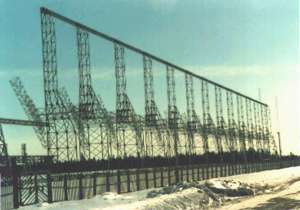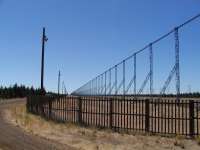AN/FPS-118
AN/FPS-118
Description of the radar set, tactical-technical characteristics

Figure 1: AN/FPS-118
| Specifications | |
|---|---|
| frequency: | 5 … 28 MHz
( HF-Band) |
| pulse repetition time (PRT): | |
| pulse repetition frequency (PRF): | |
| pulsewidth (τ): | |
| receive time: | |
| dead time: | |
| peak power: | |
| average power: | 1 MW |
| instrumented range: | 1 800 NM (≙ 3 333 km) |
| range resolution: | |
| accuracy: | |
| beamwidth: | Tx: 7.5°; Rx: 2.5° |
| hits per scan: | |
| antenna rotation: | |
| MTBCF: | |
| MTTR: | |
AN/FPS-118
The AN/FPS-118 was an early warning radar system designed to detect low-flying enemy aircraft. It is a bistatic and FMCW Doppler radar operating in HF-Band as Over-the-Horizon Backscatter Radar System (OTH-B). This radar was developed in the 1970s and 1980s to provide all-altitude, long-range surveillance of aerial approaches to the United States. Each AN/FPS-118 system consists of an operations center, a receive site, and a transmit site, all geographically separated to prevent interference. The AN/FPS-118 system employed a series of large transmitter arrays that fired off signals which bounced off the ionosphere, are backscattered by an airplane and sent a signal back to the equally large receiver arrays. AN/FPS-118 covers a 60 degree arc between 900 to 3 300 km. The transmit site of a given AN/FPS-118 was located near Moscow, Maine, USA (45°09'39.4" N 69°51'17.1" W). The associated receive site was near Columbia Falls, Maine, USA (44°42'33.2" N 67°43'41.5" W). All OTH-B radar transmitter and receiver facilities have been demolished.

